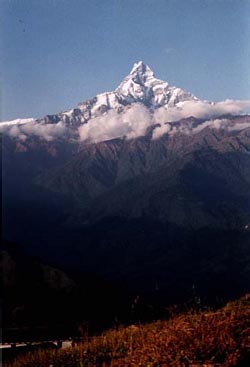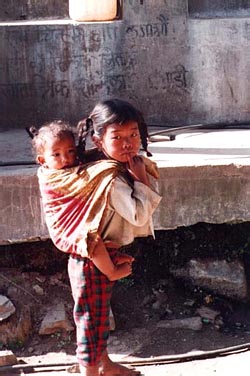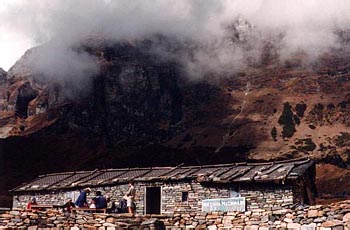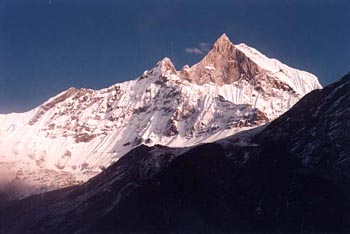

As the small twin engine aircraft used by Royal Nepal Airlines landed on the dirt runway at Pokhara, I could see Machapuchare in the distance. The snow-capped Himalayas had offered spectacular sights during the 50-minute flight from Kathmandu. They were so different from my Rocky Mountains of Colorado with their daunting sheer size and unbelievable rugged steepness.
The massive, pointed Machapuchare loomed in the distance. The reflection in the lake at Pokhara revealed how it got its nickname: viewed upside-down in the lake, it resembled a whale's tail. Supposedly it is the only mountain in Nepal for which the Government has never issued any climbing permits, choosing to have it remain the only unclimbed peak in the country. I don't know if that's true, but the story adds additional mystery to the mountain, since presumably no one has been to the summit.
As we trekked to the Annapurna Sanctuary, Machapuchare was nearly always in view. When we dropped down into the deep lush valleys, it disappeared for a while, but before long, always reappeared. As can be seen in the first photo, a band of clouds often laid just below the summit, giving the mountain the appearance of hovering above the clouds in the rich blue sky. It was easy to see how the locals could worship the Gods of the Himalayas when they appeared to float so high above we mortals.


As we approached the Machapuchare Base Camp, the afternoon clouds had begun to roll up from the canyons below. Soon we were shrouded in a cool mist at 14,000 feet. Breathing became labored, and our pace slowed so that the slowest of our group could keep up.
The base camp structures had metal roofs and offered some shelter against the cold wind that is often present. The granite rocks that the buildings were built of had no mortar to hold them together. The interior was dark and sparsely furnished, providing only a place to sleep and eat out of the elements.

Outside Machapuchare sat quietly in the glow of the evening sun, high above the valley below. It looked dangerous and beautiful at the same time. That is probably the lure for those that climb such mountains. And in Nepal they were plentiful, both the mountains and those who would climb them.
(Copyright 1998 by Keith E. Renninson - No reproduction without express permission from the author)